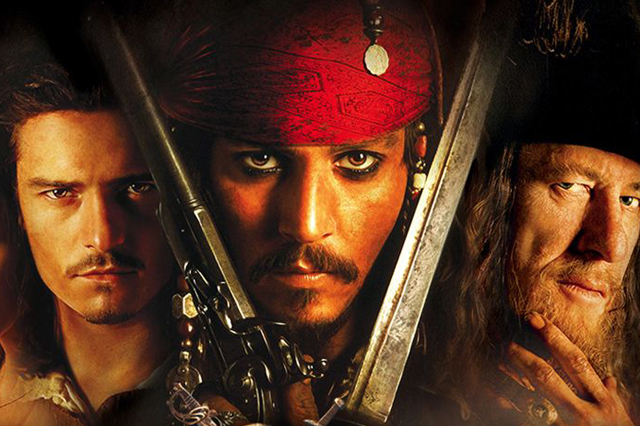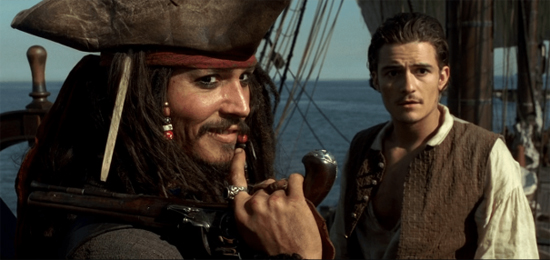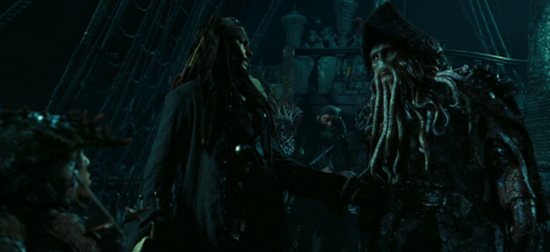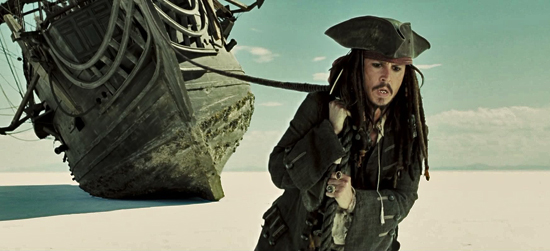
The old phrase “dead men tell no tales” could also easily apply to forgotten genres within cinema. And then, somehow miraculously, some genres rise from the dead. That was the case with the Pirates of the Caribbean franchise; the unlikeliest of blockbuster phenomenons in movie history. You have to look back at the time in which the Pirates franchise first premiered to really understand just how unusual it was. Pirates movies, as a genre, was all but dead around the turn of the millennium. Once a wildly successful part of early Hollywood, with renowned classics like Captain Blood (1935) and The Sea Hawk (1940), the genre fell off deeply in the decades after, with only a handful of noteworthy films in all that time. The final nail in the coffin came with Cannon Films notorious box office flop Cutthroat Island (1995), which all but spelled out for Hollywood that Pirate movies were poison in the cinema. So, the fact that Disney not only took another shot this troubled genre but also poured a substantial budget behind it makes the creation of these movies all the more puzzling. Couple this with the fact that the source of inspiration for these movies wasn’t a novel or a notable historical figure, but a theme park attraction. So what exactly happened to make everything go right. Turns out the “X” factor for the franchise’s success was an oddball, unconventional actor by the name of Johnny Depp. Depp was not a box office draw at the time, but somehow he struck a cord with this role, and created one of the most original characters to have appeared on the big screen in quite a long time; the notorious Captain Jack Sparrow. And not only did Jack Sparrow strike gold once for the Disney company, but he would continue to do so for a whole decade after. But, like most other things, even this couldn’t last, and now the franchise is at a crossroads. Because of waning box office, and Depp’s own off the set issues becoming a liability, it seems like Jack Sparrow’s days on the big screen are over. So, let’s take a look back at the franchise that briefly resurrected the Pirates genre and turned Jack Sparrow into a household name.

PIRATES OF THE CARIBBEAN: THE CURSE OF THE BLACK PEARL (2003)
Directed by Gore Verbinski
When action film producer Jerry Bruckheimer walked into then Disney CEO Michael Eisner’s office and pitched this idea of a movie based on the Disneyland attraction of the same name starring the actor best known for playing Edward Scissorhands, it seemed only logical to give the idea a heavy no. And yet, Eisner bit and gave the go ahead to make this movie. But, even with the project funded and well into production, the prospects still were negative given the recent box office flop of The Country Bears (2002), another movie based on a Disneyland attraction. Eisner even intervened numerous times, raising serious questions about the direction that Johnny Depp was taking his eccentric performance. But, probably to the surprise of everyone, including I’m sure even the people that made the movie, the film was a smash hit with audiences. And Disney had no one better to thank for that than Johnny Depp. Depp’s Jack Sparrow gave this movie, and the subsequent franchise, it’s identity and made it instantly stand apart from both the Pirate movie genre and all movies in general. Like a mix of Errol Flynn and Inspector Clouseau, with a little extra inspiration from rocker Keith Richards, Jack Sparrow is equal parts the greatest and worst pirate you’ve ever seen. Bumbling his way through harrowing situations, teetering between drunkenness and sobriety, Sparrow somehow seems to luck his way through any situation, making him the unlikeliest of heroes. Depp’s performance embodies every bit of this and it’s easy to see why he was so endearing to audiences. He’s also given one of the greatest character entrances in movie history, sailing triumphantly into port on a sinking boat; a perfect encapsulation of the character, and really of the impact he would have for the Pirates genre in general. And the best thing is that, even with all the questions raised beforehand, Depp was still able to form the character his way and was free to experiment and improvise throughout filming. It was risky, but rewarding as Jack Sparrow commands every scene he is in. His performance even garnered a Best Actor nomination at the Oscars (his first) which once again just shows the unprecedented success this movie had surprisingly found.
But, it’s not just Depp alone that made the movie so memorable for audiences. Director Gore Verbinski drew heavily from his background in visual effects to craft a movie that was not only felt epic, but was also effective as a showcase for cutting edge technology. The movie’s central gimmick, the curse that haunts the crew of the Black Pearl, is effectively realized through some beautifully rendered CGI which transforms the villainous pirates into skeletal figures in the moonlight. Though the effects are cool to look at, they are not distracting either, and actually mix in well with the period detail in the production design. Verbinski also draws heavy inspiration from pirate movies of the past, delivering epic sea battles that would feel at home in an Errol Flynn swashbuckler. The whole movie beautifully delivers on that mix of the old and the new, helping to remind audiences of what Pirate movies used to be like and what they could be in the years to come. Johnny Depp also gets worthwhile support from the other cast members as well. Keira Knightly saw a major career boost thanks to this movie, which propelled her into leading lady status in Hollywood. Orlando Bloom luckily stumbled onto this new franchise just as his work on The Lord of the Rings was coming to an end, and he makes a perfect straight-man for Johnny Depp to work off of. Other supporting players like Kevin McNally, Zoe Saldana, and Jonathan Pryce also stand out in the film. But, it’s Geoffrey Rush who almost matches Depp in his equally eccentric role as the villainous Captain Barbosa. The scenes with Depp and Rush alone are worth the price of admission, seeing two veteran character actors clearly having fun playing these characters. Naturally, the success of Black Pearl opened the door for this phenomenon to become a franchise, and that would indeed happen, with Disney again taking another big risk with the sequels.

PIRATES OF THE CARIBBEAN: DEAD MAN’S CHEST (2006)
Directed by Gore Verbinski
Shortly after the release of Curse of the Black Pearl, Disney made the logical choice to produce a sequel. But, what many people didn’t expect was that not one but two sequels were planned, shooting back to back with a half a billion dollar price tag for both. This was another costly gamble, but this time Disney had more belief in this property, especially now that they had a household name character like Jack Sparrow to carry it. And indeed, the gamble not only paid off, but even better than they expected. The first sequel, Dead Man’s Chest, remarkably grabbed the opening weekend crown with a then staggering $134 million three day haul. And it’s easy to see why this became the high water mark for the franchise, because it’s, in my opinion, the best in the series. Everything that made the original film a classic is ratcheted up in this sequel, with bigger set pieces, amazing visual effects, and a deeper mythology. There are many things that makes this movie work so well, but none more so than the addition of a great and memorable villain; Davy Jones. Actor Bill Nighy steals the movie with his wonderfully over-the-top performance, which remarkably still comes through even underneath the motion captured digital masking that creates the final look of the character. Motion capture was still in it’s infancy at the time, but it saw a huge step forward with Davy Jones, who looks about as authentic as he possibly could be. An equally memorable edition is the Kraken, a remarkable CGI creation that earns it’s rightful place alongside the most memorable of giant monsters on the big screen. Hans Zimmer’s musical score also hit it’s peak with this film, with his already popular Main Theme from the original joined by memorable themes for the two villainous elements; Jones and the Kraken. The film won a well-deserved Oscar for it’s visual effects, and became the highest grossing film ever for Disney at the time, cementing it’s place as key part of the company’s legacy. At this same time, Disney even took the step of putting the characters of Jack, Barbosa, and Davy Jones into the park attraction that inspired them all in the first place. With all this, and another sequel around the corner, nothing was going to slow these Pirates down in Hollywood. Right?

PIRATES OF THE CARIBBEAN: AT WORLD’S END (2007)
Directed by Gore Verbinski
Released less than a year after Dead Man’s Chest, At World’s End looked primed to cap this trilogy off strong. In a post-Lord of the Rings world, much became expected of trilogy enders, as The Return of the King (2003) was easily the biggest film of that epic series. As a result, it appeared that Gore Verbinski and Jerry Bruckheimer wanted to go out on a similar note, taking the franchise to even further epic heights. Unfortunately, the end result did not have the same effect as Return of the King. At World’s End is by no means a bad movie, but it doesn’t have the same focus that it’s predecessors had. The movie is bloated, running nearly 3 hours long, with a lot of unnecessary sidetracks that lead nowhere. The movie starts off promising with a beautifully constructed set piece recreating Singapore in the era of Pirates, which also brings in legendary Hong Kong cinema icon Chow Yun Fat as a nice addition to the cast. There is also a wonderfully weird sequence of Jack Sparrow stranded in Davy Jones’ Locker, which seemed to be heavily inspired by the work of another favorite collaborator of Depp’s, Terry Gilliam. But, after a strong opening, the movie sags as the uneven plot looses balance. Alliances break down, characters plot behind others’ backs for no reason, and there are just too many scenes where there’s a lot of talking and not enough action. Also, some of the pirate lore and magical elements are never fully realized, making the whole thing hard to follow. Still, Depp shines as Jack Sparrow, and his final showdown with Davy Jones in the middle of a storming Maelstrom is breathtaking to watch. While the whole is a convoluted mess, there is still a lot to like in the movie, and it does tie up the trilogy effectively enough. But, it is still the weakest of the trilogy under Verbinski’s direction. The movie made less than it’s predecessor, but still well enough to keep Disney in the black. For the time, this should have been the time to hang up the swords and leave the franchise complete as is, because it was clear that by the end of At World’s End, the series was loosing it’s momentum. But of course, with a property as profitable as this one, Hollywood just can’t leave well enough alone.

PIRATES OF THE CARIBBEAN: ON STRANGER TIDES (2011)
Directed by Rob Marshall
After taking a much needed break, Disney went right back to the well to get more out of this franchise. Verbinski had moved on, and was already deep into development on another collaboration with Disney and Johnny Depp (The Lone Ranger), so the studio turned to a different director in their stable to tackle this next chapter. Rob Marshall had already made a splash in Hollywood with his Oscar-winning musical Chicago (2002), but had yet to apply his cinematic skills into an action film. And that inexperience is the biggest problem with On Stranger Tides. The whole movie is a pale imitation of it’s predecessors precisely because Marshall can’t stage the film’s action set pieces with the same flair that Verbinski had. There is just a severe lack of fun to the whole movie, and Johnny Depp especially is shackled by this movie’s lack of creative drive. More than anything, this movie feels like it suffered from the most studio interference, as the whole thing comes across as a paint by numbers rendition of all the thing that had come in the series before. Perhaps the biggest disappointment, however, is the movie’s villain; Blackbeard. Casting a great, larger than life actor such as Ian McShane in the role should have made this character legendary, and yet Blackbeard is just a shallow, uninspired baddie that utilizes none of McShane’s charisma or menace. Davy Jones he is not. The addition of Penelope Cruz as a love interest for Jack Sparrow fairs a bit better, and the movie briefly comes to life whenever her and Depp share the screen. Also, Geoffrey Rush returns as a more grizzled Barbosa, and is by far the best part of this movie. Watching his work here really convinced me that Barbosa is my favorite character in the entire franchise, mainly because he can still shine in even the most mediocre of films. Stranger Tides is rock bottom for the Pirates franchise, mainly because it makes the cardinal sin of being boring and safe, which is contrary to what made these movies work in the first place. With bland action set pieces (apart from a sequence that miraculously makes mermaids scary), a wooden cast of new characters, and no real reason to exist, this was the worst possible direction that the studio could have taken their cash cow of a franchise.

PIRATES OF THE CARIBBEAN: DEAD MEN TELL NO TALES (2017)
Directed by Joachim Ronning and Espen Sandberg
A full fourteen years after the launch of the franchise, Disney believed they could wring just a little more out of these Pirates. But given Stranger Tides lackluster results, was it really worth the risk. Johnny Depp did not have the same box office appeal anymore after a string of costly flops (The Lone Ranger among them) and his recent bad behavior making headlines was also not beneficial to the prospects for a continuation of the franchise. But, Disney still saw the potential. They made the right choice and hired Norwegian directors Ronning and Sandberg, who gained notoriety for their critically acclaimed sea-faring Kon-Tiki (2012). And while their grasp on Pirates convoluted mythology still wasn’t good enough to right the ship completely, they at least staged their action set pieces better than Rob Marshall did, especially a really clever one involving a gag with a guillotine. The movie also benefits from a charismatic villainous turn by Javier Bardem as the half dead Captain Salazar, who at least comes off as more menacing than McShane’s dull Blackbeard. Sadly, these are the only positive things to say about the movie, because the rest of the film is just the same old tired tricks again. Johnny Depp especially looks bored in this movie, and while he still has moments that shine, it’s clear that the Jack Sparrow shtick had run it’s course. Apparently he even needed an earpiece to feed him lines during filming, showing just how little he cared at this point. The movie’s convoluted plot also drags the movie down, and even tries to drag up past plot points that we thought were done and over with (Orlando Bloom and Keira Knightly both appear in pointless cameos that add little to their character arcs). And again, the mythology just feels lazy at this point; once centered around incredible icons like the Kraken and Davy Jones’ Locker, the series now wanted us to care about Neptune’s Trident, which I still don’t understand how the mechanics of it works. And you bring Barbosa back to life, just to kill him off again? Seriously? It was clear that this ship was wildly off course and should have been left in the harbor. And given it’s lackluster box office performance, that seems to be the message that it left on Disney afterwards.
It is still remarkable that a movie that should have never worked managed to do just that, and spawn a five film franchise that spanned over a decade. But, the Pirate revival was short lived, even while Pirates was still riding high. Pirates of the Caribbean didn’t have the same carry over effect on the industry that other genre revivals like Gladiator (2000) and The Lord of the Rings had around the same time. Other studios didn’t set out to make Pirate movies of their own. Pirates of the Caribbean ended up just sitting on it’s own as an anomaly within the industry. But, it was one that did help the Walt Disney out in a transitional time in their history. As the Michael Eisner era gave way to the Bob Iger era, Pirates was the single biggest source of income for the studio, and it helped them gain the capital they would need to further expand in the years ahead with Marvel and Star Wars, and weather the disappointments along the way. Though the decline of the series was disappointing in the long run, the fact that these movies exist at all and were worth seeing is a miracle. Pirate movies were a dead franchise, and yet somehow this franchise bucked the trend and became a success. Finding the buried treasure in the character of Jack Sparrow was a key part of that, and I love the fact that he now is as noteworthy a part of the Disney legacy as the likes of Mickey Mouse or Donald Duck. Also, the franchise was at it’s best when it had confidence in it’s own identity, even separated from the Disneyland ride. The references in the early films were easy to spot, like the dog with the keys and skeleton Barbosa drinking a bottle of rum, but they didn’t distract from the story at large. Pirates was it’s own unique thing, and the only thing that anchored it down in the end was it’s inability to be anything else. I think that’s why Disney is deciding to retire Jack Sparrow as a character and relaunch the series anew. But, the era that Jack Sparrow reigned was a weird and adventurous one, and even though the rum’s run dry on this series, it’s will still hold an infamous place as a true Hollywood original. Drink up me hearties, Yo Ho.